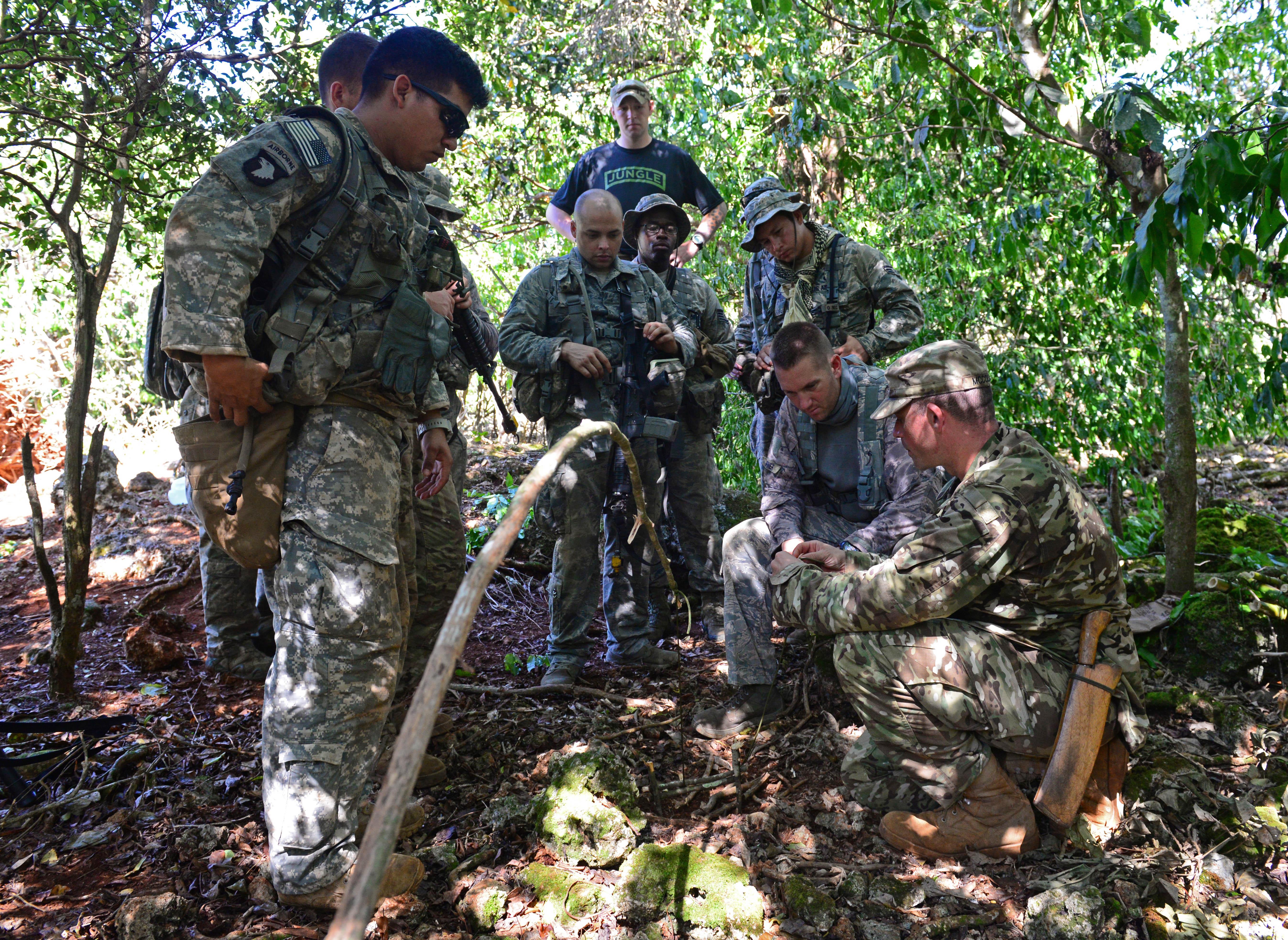Through The Thick Of It: Airmen, Soldiers Tackle Joint Jungle Training
By Senior Airman Joshua Smoot, 36th Wing Public Affairs, Published 30 June 2016
Airmen and Soldiers learn how to set animal traps and snares during the Jungle Training Operations Course June 17, 2016, at Andersen Air Force Base, Guam. From June 15-21, instructors from the U.S. Army 25th Infantry Division’s Lightning Academy Jungle Operations Training Center, in Schofield Barracks, Hawaii, travelled to Guam to teach more than 30 Airmen and Soldiers the fundamentals of fighting and surviving in jungles with support from cadre members of the 736th Security Forces Squadron. (U.S. Air Force photo by Senior Airman Joshua Smoot)
ANDERSEN AIR FORCE BASE, Guam -- Veiled in darkness, two MH-60 Seahawks cut through the humid night air heading toward a landing zone in an abandoned military building complex.
Inside each helicopter, Airmen and Soldiers take deep final breaths attempting to calm their nerves. A crew chief turns his head and then alerts everyone onboard with a booming “30 seconds!” that their drop is coming up.
After checking their weapons and placing their night vision goggles over their eyes, the team prepares for landing. On the ground, their dark silhouettes rush from the aircraft and drop for cover in the tall grass.
Seven days of training prepared the military students for this moment. They are taking part in the final exercise of the Jungle Training Operations Course at Andersen Air Force Base, Guam. From June 15-21, instructors from the U.S. Army 25th Infantry Division’s Lightning Academy Jungle Operations Training Center, at Schofield Barracks, Hawaii, travelled to Guam to teach more than 30 Airmen and Soldiers the fundamentals of fighting and surviving in jungles with support from cadre members of the 736th Security Forces Squadron.
“This jungle operations training is important, because it helps build Department of Defense readiness and service interoperability,” said U.S. Army Staff Sgt. Sydney Hays, JTOC instructor. “The high caliber training is a force multiplier applicable across the U.S. Pacific Command area of operations.”
The idea of hosting the condensed training at Andersen AFB came up when Master Sgt. Jeremy Burkeen, 736th SFS operations superintendent, and the squadron’s director of operations attended the 14-day Jungle Training Operations Course in Hawaii nearly a year ago.
“This training is a lost art,” Burkeen said. “With the push to the Pacific and the threats that lie in the Pacific Rim, we have to get back to the basics of airmanship and soldier skills.”
Guam served as an ideal alternate location to Hawaii with its relatively humid and warm climate and dense vegetation. Besides battling the heat, the students avoided run-ins with the local wildlife including monitor lizards, feral pigs and the infamous boonie bees.
The trainees were individually selected from several career fields across the DOD, including Airmen from the 36th Security Forces Squadron, 736th SFS, 554th RED HORSE Squadron, 644th Combat Communications Squadron and infantrymen from the 94th Army Air and Missile Defense Command’s Task Force Talon. For many of them, this was the first time operating in a jungle environment.
On the first day, participants had to prove they had what it took to make it through the course. The students were tasked with completing an aptly-named two and a half mile terrain appreciation run beginning at Tarague Beach.
“The run measured the motivation levels of the students in attendance,” Burkeen said. “It allowed the cadre to set the pace for the remaining of the training. You hit (it hard) from the get go so they know what to expect throughout the course.”
After devouring their Meals, Ready to Eat, trainees joined the instructors for an introduction to survival and navigation tactics in jungle terrain. The teams learned how to trap and snare animals, how to prepare their food once captured and several ways to purify drinking water.
After hours putting the techniques to practice, Airmen and Soldiers teamed up with U.S. Navy Sailors from the Helicopter Sea Combat Squadron 25 for jungle air-to-ground procedures, medical evacuation training and air assaults.
After the third day of training, fatigue from sleep deprivation began taking a toll as the teams only slept for a few consecutive hours and were challenged to pace their calorie intake to make their once-daily meal rations last, Burkeen said.
With the week drawing to an end, the students faced one final test of their ability to operate in a tropical environment. Arriving via helicopter, the teams set out to locate a hidden weapons cache. After achieving their initial objective, the teams then secured their position and prepared for nightfall.
When dawn arrived, they initiated an ambush on opposing forces and evacuated a simulated casualty by helicopter. Following a successful rescue, the crew received a new mission, tasking them to put their new skills to use in traversing difficult jungle terrain to raid an enemy hideout. As nightfall once again took over, Airmen and Soldiers executed their final ambush before being extracted and vanishing from the training site as fast as they arrived.
The students left the course with an added respect for the environment and each other. By overcoming the same obstacles throughout the course, teams developed a renewed sense of camaraderie between people who normally don’t work in the same units and will be able to share newly-acquired skills with their wingmen.
“This course was more difficult than I anticipated, but I learned that no matter what you go through, you can push through it,” said Staff Sgt. Ryan Dirner, JOTC student from the 736th SFS. “I enjoy this type of training and it is extremely valuable to what we do.”
The pre-sale for “Sky-Cops and Peacekeepers” is now on! Please drop by www.chrisaphotography.com to get your order in.
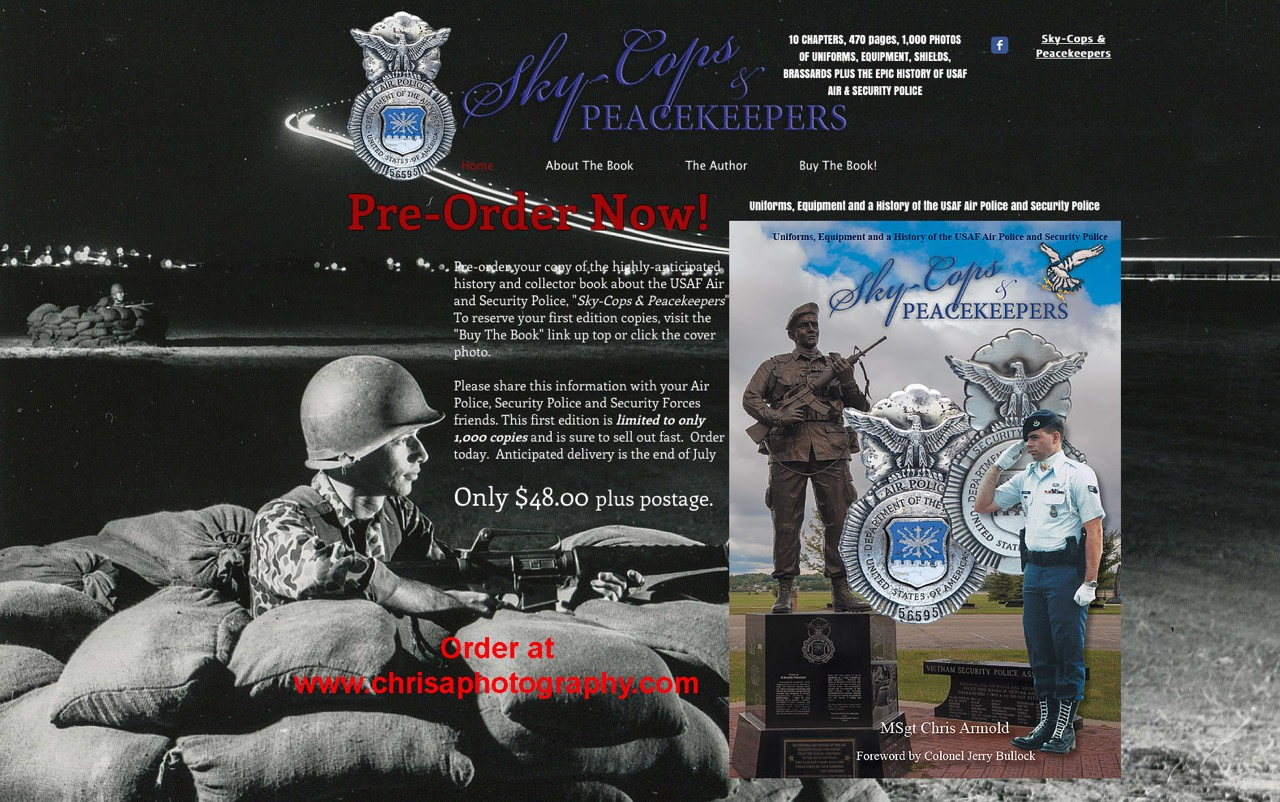
PRE-ORDER your copy of the epic Air Police Security Police visual history, "Sky-Cops and Peacekeepers" The first printing is limited to 1,000 copies and they are going fast! 50 copies have sold all ready. Visit www.chrisaphotography.com to get your pre-order in. Approximately 470 pages, approximately 1,000 photos, perfect bound, full color... .just awesome. Order today and e-mail and help me sell out! The book goes to print next week and anticipated shipping to you is the end of July. If you have questions, need help or see a glitch with the website please e-mail me at This email address is being protected from spambots. You need JavaScript enabled to view it. Buy two, three or four copies for your kids and grandkids! These will make amazing gifts for any cop in your life.
If you have questions or need additional information please contact me at This email address is being protected from spambots. You need JavaScript enabled to view it. or call me at 937-572-5581. Please share this with your friends, vets and active duty troops. It’s a great book with a fantastic visual story of our force!
Thanks for your interest
Chris Armold, MSgt, USAF (Ret)
AFSFA Member
Defender Dog Handlers .... great cause supporting current day USAF handlers!
Old Dawgs & Pups Needs YOUR Help!
SO THIS PATCH IS A FUNDRAISER!
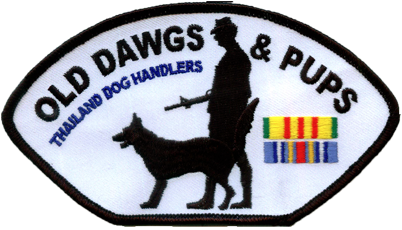
We’ve supported more than 500 Military Working Dog Teams since we started this program in 2005. We’ve had a lot of support from our major corporate sponsors, donations from VSPA and the VDHA, and individual donations from all of you.
However, right now we’re getting short on the funds we need to purchase and ship the supplies that our troops and their K-9 companions need and enjoy.
This NEW Old Dawgs & Pups patch can be yours for a donation of $15 per patch, and the funds we raise, as always, go directly to the MWD Teams in harms way in Southwest Asia.
The patch is 5.25 inches wide, and will fit on a cap, the shoulder or chest of a shirt or jacket, and it’s got heat-seal on the back so you can iron it on yourself. It also makes a great addition to a patch collection just pinned on a wall. Let’s see, do military folks and cops ever have patch collections? Do you know any military, cops or ex-cops? Well, there you go - that’s your gift list.
Just send a check or money order for $15 PER PATCH to Phil Carroll to order your patches. Your patch or patches will go in the mail to you right away. We are not set up to take credit card orders – Sorry!
1. Make check payable to: Phil Carroll
2. Send check to:
Phil Carroll
P.O. Box 8
Gladstone, OR 97027
All inquiries concerning purchase of these Old Dawgs & Pups coins must be directed to Phil Carroll at This email address is being protected from spambots. You need JavaScript enabled to view it.
U.S. Army and Air Force Agonize Over Picking a New Handgun
Popular Mechanics, By Kyle Mizokami, May 31, 2016
The Beretta M92 ranks at the bottom of all the firearms used by the U.S. Army and Air Force—but it'll take the Pentagon years to field a replacement.
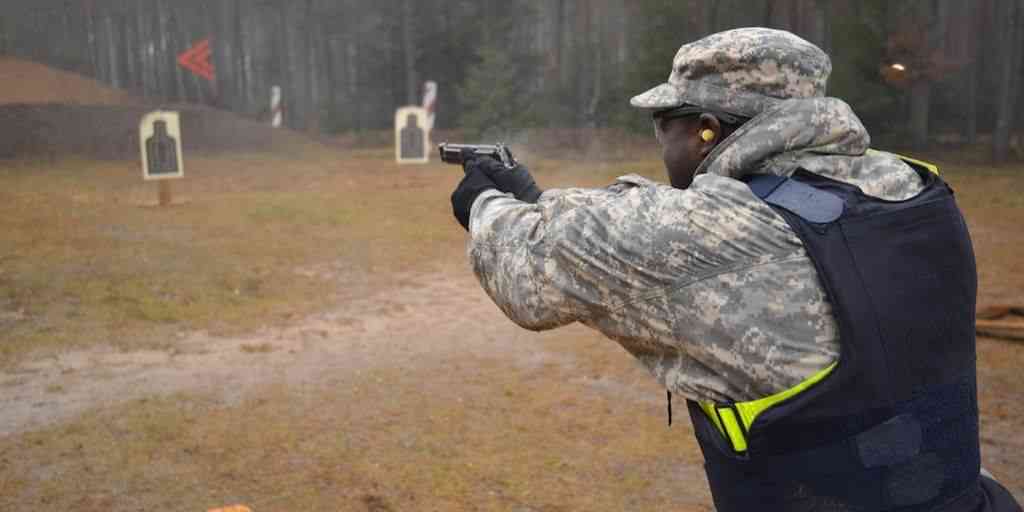
The Department of Defense will soon choose three finalists in a competition to be the U.S. Army and Air Force's new sidearm. One of the three finalists could go on to outfit all of the services, with total sales of of 500,000 handguns—but not before the Pentagon bureaucracy makes it as long and complicated as possible.
The Modular Handgun System (MHS) is a $17 million dollar effort to replace the aging Beretta M92 handgun. First adopted in the 1980s, the U.S. Army's Berettas are beginning to wear out. The M92 is also a product of another time, and hasn't kept up with recent advances in pistol technology.
The first requirement is that the new handgun surpass the M92 in accuracy, reliability, ergonomics, durability, and maintainability. In a 2006 report on U.S. infantry weapon reliability, the M92 scored at the bottom compared to the M4 carbine, M16 rifle, and M249 squad automatic weapon. In every category, from handling to accuracy to maintainability, the M92 came in dead last—or tied for last.
Twenty-six percent of soldiers polled reported their weapon jammed while shooting at the enemy. Forty-six percent reported they didn't have confidence in their pistol's reliability.
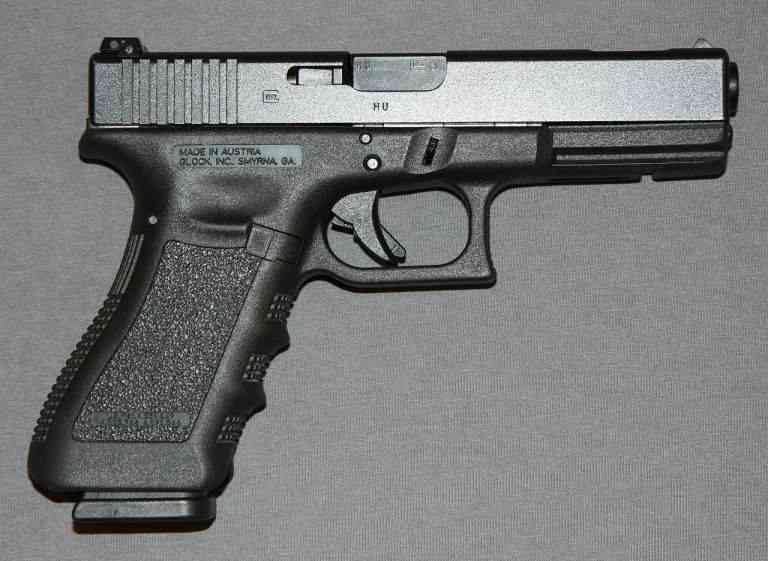
Glock 17
The MHS will also incorporate new advances in infantry small arms. The pistol will have a modular grip system, a recent development that involves interchangeable, different-sized grip panels to accommodate larger or smaller hands. This has become an important feature as the percentage of women in the military—who tend to have smaller hands—has jumped 50 percent since the 1980s when M92 was adopted.
The handgun will have an integral MIL-STD 1913 Picatinny Rail underneath the barrel, allowing the attachment of gadgets such as flashlights and lasers. It will also have a threaded barrel to accommodate a suppressor and should have low recoil.
Currently there are twelve bidders for the contract, including the Beretta APX, Ceská Zbrojovka's CZ P-09, FN Herstal's Five-Seven Mk 2, General Dynamics Ordnance and Tactical Systems (GDOTS) and Smith & Wesson's M&P polymer handgun; the Glock 17 and 22; and Sig Sauer's P320. An updated version of the M9, the Beretta M9A3, was rejected by the Army and won't be involved in the competition.
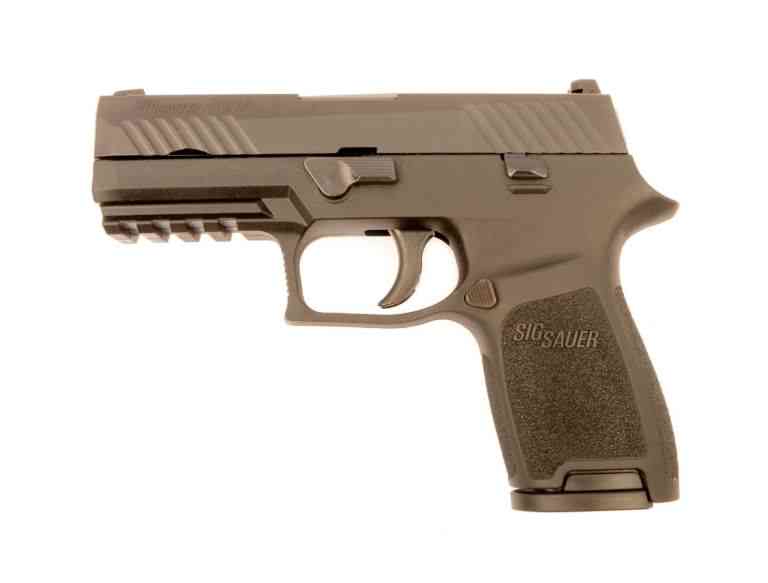
Sig Sauer P320
The pistol's caliber is still up in the air. Nine-millimeter and .40 Smith & Wesson appear to be the top contenders, with FN's 5.7-millimeter pistol also in the running, shooting a bullet that hadn't been invented when the M92 was first fielded. The venerable .45 ACP round, used for decades with the M1911A1 pistol, appears to have been disregarded due to the round's perceived heavy recoil.
The selection process—beset by the Pentagon bureaucracy—is progressing at a snail's pace. First begun in 2015, the MHS program will chose three semifinalists in August, with a nine-month evaluation process to follow. A winner will be picked afterward, with the winning entry to go into "low rate production." That means it will be at least another thirteen months before any pistols are delivered to the military.
The program's complexity has been stifling, prompting complaints from the Army's top general and Congress. The paper outlining the MHS's requirements runs a ridiculous 350 pages. Senator John McCain described the handgun selection process as "byzantine", and Army Chief of Staff General Mark Miley complained in March, "We're not figuring out the next lunar landing. This is a pistol. Two years to test? At $17 million?" Miley claimed he could walk into a Cabelas outdoors store with $17 million dollars and buy a handgun for every person in the military.
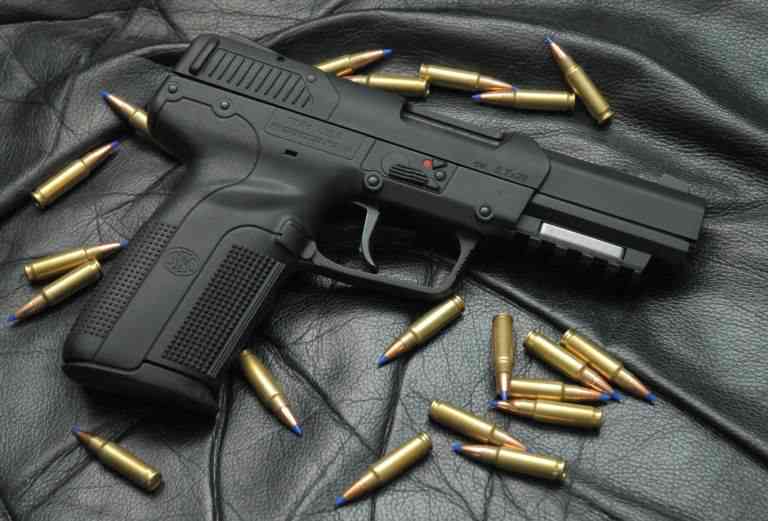
FN Herstal Five-seven
Miley may be exaggerating on how many pistols he could buy—even with a 20 percent bulk discount, $17 million would still only score you 40,000 Glock 17 pistols—but he's not wrong about the guns themselves. Practically every entrant for the Modular Handgun System is already on the lucrative civilian market in the United States, owned by thousands—in some cases, such as the Glock 17—by millions. The selection should be a fairly easy choice.
For most gun owners, buying a new handgun is a quick process that takes no more than a few hours scrutiny. For the Pentagon, it's a process that requires hundreds of pages of paperwork and years of hand-wringing before even finalists can be named.
DoD Plans Benefit Revision With ‘Blended Retirement’
By Karen Parrish DoD News, Defense Media Activity
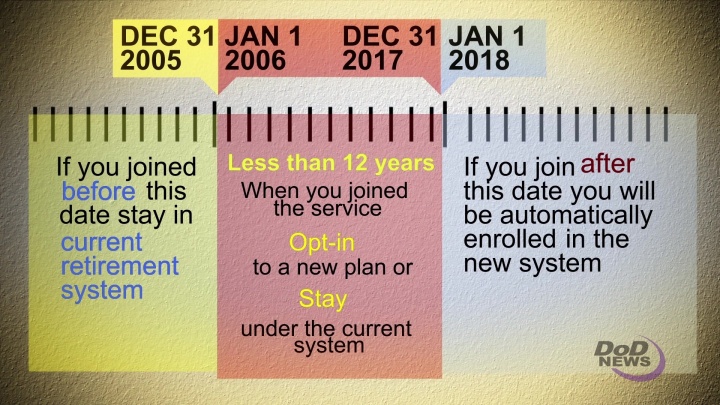
Changes to the military's retirement system could have a big impact on the way you invest in your future.
WASHINGTON, Feb. 12, 2016 — Upon taking office almost a year ago, Defense Secretary Ash Carter promised reforms, saying “that a blended retirement system is a key step in modernizing the department’s ability to recruit, retain and maintain the talent we require of our future force.”
An overhaul of the current military retirement system is slated to take effect January 1, 2018. The new system has three elements: a 401(k)-style component with Defense Department matching funds for entry-level and other service members, a mid-career continuity bonus, and a retirement annuity similar to the one now in place for service members that complete twenty or more years of eligible service.
DoD News spoke with Army Sgt. Maj. Mike Schultz while he was the senior enlisted advisor to the Assistant Secretary of Defense for Manpower and Reserve Affairs about the details of the new modernized retirement system.
One key point, Schultz said, is that many of those now serving will have the choice to opt into the new blended retirement plan.
Training the Force on Retirement Options
The first critical step in the change, he said, is educating senior leaders about the program’s provisions. Those leaders will then ensure training takes place at the “camps, posts and stations” where service members work.
Training tools now in the works will include online classes and benefits calculators for troops and their families, as well as classroom and distance learning, Schultz added.
He said the “deliberate approach to educate the force” will be a key effort from now until rollout.
Grandfathering and Opting In
The sergeant major said the question he hears most often about blended retirement is: “What will it mean to me?”
First, he said, all troops now serving are grandfathered and will be allowed to remain in the current system.
Those who have served in uniform for fewer than 12 years as of December 31, 2017, will have a choice to stay in the current system or to opt into the new retirement plan, Schultz said, and those who enter service after the blended retirement rolls out will automatically be covered by the new modernized retirement system.
Incentives, ‘Portability’ Built In
The phase-in will, Schultz noted, both keep faith with those who could retire under the current system, and offer new options for what he termed a “portable” retirement benefit plan to those who will serve in the future.
The aspects that make the plan “blended” are automatic and matching government contributions in the Thrift Savings Plan, similar to a 401(k) and transferable on leaving service, for service members in the new retirement plan, and retaining lifetime monthly retired pay for those who serve at least 20 years.
The government will automatically contribute 1 percent of a member’s basic pay into the member’s TSP account even if the member contributes nothing. After 24 months of service, the government will match member contributions, dollar-for-dollar, up to the first 3 percent the member contributes and fifty cents per dollar for the next 2 percent the member contributes.
Thus, if a member contributes 5 percent into the member’s TSP account, the government will contribute an additional 5 percent (1 percent automatic plus 4 percent matching), Schultz said. Members who serve at least 24 months and then separate will be able to keep the government contributions and transfer them to a new employer’s retirement plan. For service members that stay in the military for a full career of 20 years or more, the new plan continues to offer monthly retired pay similar to today’s system, although it will be computed based on a length-of-service factor of 2 percent per year, instead of the 2.5 percent per year used in the current system.
“A midcareer bonus is in addition to the TSP account and the 20-year annuity modeled on the current plan,” Schultz said. The DoD will pay a bonus of at least two and a half months’ basic pay (one-half month for reserve and National Guard members not serving in a full-time capacity) to those service members who have served 12 years and who agree to remain in uniform for four more years.
Stay tuned during the coming months as additional information and opportunities to learn more about the new blended retirement system become available.
Page 45 of 50
